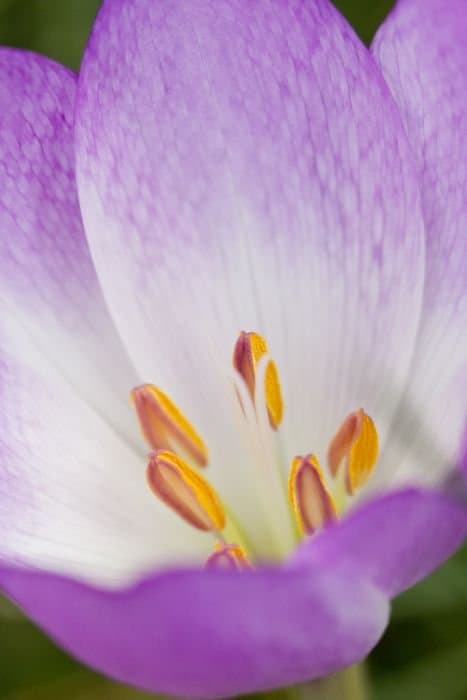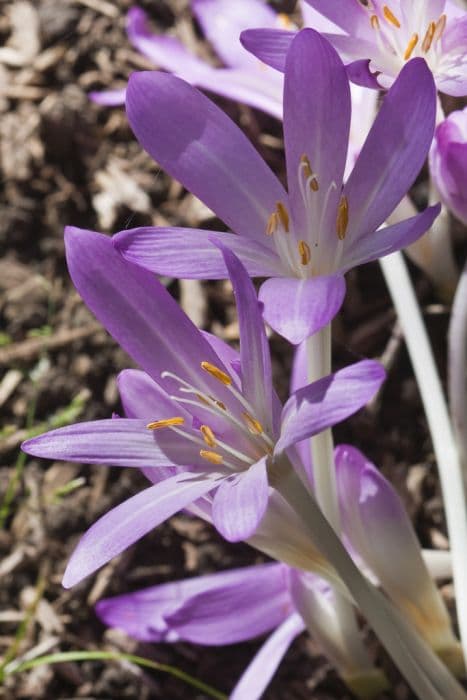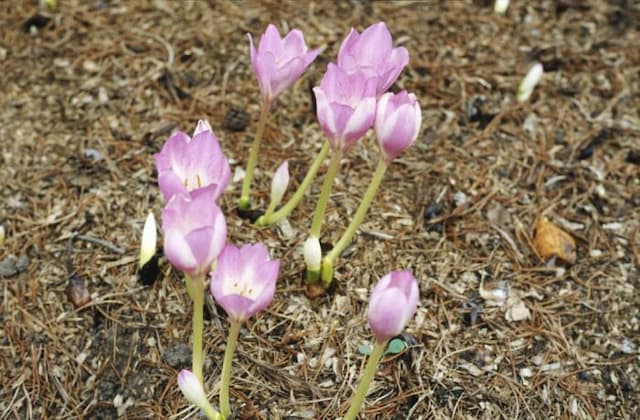Autumn Crocus Colchicum speciosum 'Atrorubens'

ABOUT
The autumn crocus 'Atrorubens' stands out with its strikingly rich and deep hues. It features an eye-catching array of cup-shaped flowers whose colors can be described as a blend between wine-red and violet. These vivid petals have a lustrous sheen, which is complemented by contrasting white throats at the base of each flower segment. Emerging on slender, stem-like tubes, the flowers typically grace gardens with a burst of color. The leaves are glossy in texture, contributing to the plant's overall elegance. They are generally elongated, with a lush green shade that amplifies the dramatic flowers. As the blooms fade, the foliage gains prominence, broadening and providing a verdant backdrop in the landscape.
About this plant
 Names
NamesSynonyms
Giant Meadow Saffron, Autumn Crocus, Specious Colchicum, Showy Colchicine
Common names
Colchicum speciosum 'Atrorubens'.
 Toxicity
ToxicityTo humans
Colchicum speciosum 'Atrorubens', commonly known as autumn crocus, is highly toxic to humans due to its colchicine content. Ingesting any part of the plant can lead to serious health issues. Symptoms of poisoning may include gastrointestinal distress like vomiting, diarrhea, abdominal pain, and severe thirst. More severe effects include organ failure, respiratory depression, seizures, and can be life-threatening. Medical attention should be sought immediately if ingestion is suspected.
To pets
Autumn crocus (Colchicum speciosum 'Atrorubens') is also toxic to pets. It contains colchicine, which is hazardous if ingested. Symptoms in pets can include drooling, vomiting, diarrhea, abdominal pain, and bloody stools. Severe cases may lead to organ damage, shock, or even death. Immediate veterinary care is crucial if a pet has consumed any part of the plant.
 Characteristics
CharacteristicsLife cycle
Perennials
Foliage type
Deciduous
Color of leaves
Green
Flower color
Purple
Height
6 inches (15 cm)
Spread
3 inches (7.5 cm)
Plant type
Bulb
Hardiness zones
4
Native area
Caucasus
Benefits
 General Benefits
General Benefits- Aesthetic Appeal: Colchicum speciosum 'Atrorubens', commonly known as autumn crocus, has vibrant deep purple blooms that add color to gardens during late summer and fall.
- Low Maintenance: It is relatively easy to grow and does not require significant maintenance, making it an attractive option for gardeners of all levels.
- Drought Resistance: Once established, autumn crocus is drought-tolerant, reducing the need for frequent watering.
- Naturalization: This plant has the ability to naturalize, meaning it can spread and propagate on its own, creating a larger display over time.
- Pollinator Friendly: The flowers attract pollinators such as bees, providing an important nectar source late in the growing season.
 Medical Properties
Medical Properties- Alkaloid content: Colchicum speciosum 'Atrorubens' contains colchicine, a compound that has been used historically to treat gout by reducing inflammation and decreasing uric acid levels.
- Anti-inflammatory action: Due to the colchicine, it may have anti-inflammatory properties helpful for reducing swelling and pain in conditions such as gouty arthritis.
- Antimitotic agent: Colchicine from Colchicum speciosum 'Atrorubens' acts as an antimitotic drug, which means it can interfere with cell division, a property that has been utilized in the treatment of certain cancers.
- Treatment of Mediterranean fever: Colchicine is known to be effective in treating familial Mediterranean fever, a genetic disorder that causes recurrent fevers and inflammation.
 Air-purifying Qualities
Air-purifying QualitiesThis plant is not specifically known for air purifying qualities.
 Other Uses
Other Uses- Education and Research: Colchicum speciosum 'Atrorubens' can be used for educational purposes in botany and horticulture to study plant physiology and flowering patterns, particularly autumn blooming behavior.
- Insectary Plant: It can help support and attract pollinators like bees during its flowering season, boosting the overall health of the garden ecosystem.
- Photography: The vibrant colors and unique appearance of Autumn Crocus make it a popular subject for nature photographers and botanical illustrators.
- Artistic Inspiration: Artists may use Autumn Crocus as a subject or inspiration for paintings, drawings, and other forms of visual art due to its striking appearance.
- Cultural Symbol: In some cultures, Autumn Crocus may be used in art and literature as a symbol of the onset of autumn or the fleeting nature of beauty.
- Fabric Dyes: Historically, plants in the Colchicum genus were sometimes used to create dyes for fabrics, though there is less documentation specifically on Colchicum speciosum 'Atrorubens'.
- Seasonal Celebrations: Autumn Crocus can be incorporated into seasonal wreaths or floral arrangements for autumn festivals and celebrations.
- Garden Design: Used for its specific flowering time, it can be part of a carefully planned garden that ensures sequential blooming, providing a continuous display of flowers.
- Flower Language: In the Victorian language of flowers, Colchicum speciosum could be presented to convey a message of foresight or my best days are past, resonating with its fall blooming attribute.
- Scented Gardens: While not known for a strong fragrance, Autumn Crocus could still contribute to a scented garden designed to peak during different times of the year.
Interesting Facts
 Feng Shui
Feng ShuiThe Autumn Crocus is not used in Feng Shui practice.
 Zodiac Sign Compitability
Zodiac Sign CompitabilityThe Autumn Crocus is not used in astrology practice.
 Plant Symbolism
Plant Symbolism- Renewal: Colchicum speciosum 'Atrorubens', commonly known as Autumn Crocus, often symbolizes new beginnings and renewal because it blooms unexpectedly in the fall while most other plants are preparing to go dormant.
- Hope: The Autumn Crocus's ability to emerge during the chilly days of autumn provides a symbol of hope and the promise that life continues even as the colder months approach.
- Resilience: It represents resilience in coping with adversities since it thrives in conditions that are typically harsh for other flowers, signifying the ability to persevere through tough circumstances.
- Beauty and Vanity: Due to its attractive and prominent flowers that stand out in the fall landscape, the Autumn Crocus can symbolize both beauty and, sometimes, vanity, reflecting the duality of beauty being admired yet also leading to self-admiration.
 Water
WaterAutumn crocus requires even moisture, especially during the spring and fall growing seasons; while it is dormant in summer, reduce watering significantly. Generally, water the plant with about 1 inch of water per week, depending on the soil and weather conditions. Ensure the soil is well-draining to avoid waterlogging. During the active growth period, water thoroughly when the top inch of soil feels dry to the touch. Do not water generously during its dormancy in the summer, as too much moisture can lead to bulb rot.
 Light
LightAutumn crocus thrives in full sun to partial shade conditions. The ideal spot for this plant is an area that receives morning sunlight and is partially shaded in the intense afternoon heat. This ensures that the delicate blooms are not damaged by the strong sun while still receiving enough light to grow properly.
 Temperature
TemperatureAutumn crocus is hardy and can tolerate temperature extremes from around -20°F to 80°F. However, the ideal growth temperature range for this plant is between 50°F and 70°F. Protecting the plant from extreme cold and ensuring it is not exposed to prolonged periods of high temperatures will contribute to its overall health and blooming.
 Pruning
PruningPruning is typically not necessary for autumn crocus, except for removing spent flower stems after blooming and yellowed or dead leaves in late spring when they begin to die back naturally. This light maintenance helps to direct energy back to the bulb and keep the garden tidy. The best time for this is after the blooms have faded and the foliage starts to decline.
 Cleaning
CleaningNot needed
 Soil
SoilAutumn crocus prefers well-draining, fertile soil with a neutral to slightly alkaline pH (6.5-7.5). A good mix can be made with equal parts of loam, sand, and leaf mold or compost to provide the necessary nutrients and drainage.
 Repotting
RepottingAutumn crocus typically does not require frequent repotting and can be left undisturbed for several years. They should be repotted only when the bulbs become overcrowded, usually every 4 to 5 years.
 Humidity & Misting
Humidity & MistingAutumn crocus fares best in average humidity levels. Excessively dry or overly humid conditions are not ideal; maintaining ambient room humidity is sufficient for this plant.
 Suitable locations
Suitable locationsIndoor
Provide bright light, pot in a well-draining mix.
Outdoor
Plant in full sun to partial shade in well-drained soil.
Hardiness zone
4-9 USDA
 Life cycle
Life cycleThe Colchicum speciosum 'Atrorubens', commonly known as the Ornamental Onion, initiates its growth from a corm, which is an underground storage organ. In late summer to early autumn, the plant produces striking, deep purple-pink flowers directly from the corm before the leaves appear. After flowering, the foliage emerges, typically in the form of long, glossy green leaves that engage in photosynthesis and enable the plant to store energy back into the corm. During late spring, as the temperature rises, the leaves die back and the plant enters a period of dormancy through the hot summer months. Throughout this dormant period, the corm remains underground until the environmental conditions become favorable again for the next flowering cycle. Year after year, this perennial cycle repeats, with the corm often producing offsets that can give rise to new plants.
 Propogation
PropogationPropogation time
Late summer
Autumn Crocus typically propagates through division, which is best done when the plant is dormant in summer after the foliage has died back. To propagate by division, carefully lift the clump of corms from the ground using a spade or fork. Gently separate the corms from the parent plant, making sure each division has at least one growth point. Replant the divided corms immediately at a depth of about 4 inches (10 centimeters), spacing them approximately 6 inches (15 centimeters) apart to give them ample room to grow. Water the newly planted corms well to help establish them. This process allows the expansion of the garden or the sharing of these spectacular flowers with fellow gardeners. It's important to handle the corms with care as they contain alkaloids which are toxic if ingested and can cause skin irritation.








